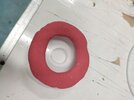Follow along with the video below to see how to install our site as a web app on your home screen.
Note: This feature may not be available in some browsers.
So 1/50
It's 1uF 50V - common long ago, probably mostly in the USA?.So 1/50 View attachment 133426= 1uF? I'm unfamiliar with this annotation?
Ah. Thanks.It's 1uF 50V - common long ago, probably mostly in the USA?.
You're perhaps too young?Ah. Thanks.
You just made my day!You're perhaps too young?
ex Doctor my 9 v battery is to heavy to carry around your neck has any body has a 3v amp heartbeat, recorded thanksToday, I have tried to build the circuit using resistors and capacitors i have while waiting for ordered parts to arrive. I was building preamp circuit with the gain of 21 based on below schematic. R1+R2+R3 are used to drop 5.6 V across them since my electret seems to draw only 0.33 mA rather than 0.5 mA. Keep in mind that the output jack is trrs for connecting to phone.
View attachment 132727
What I found was that I couldn't hear any heartbeat, recorded by voice recorder program on my phone, using the circuit above. However, if the electret mic directly connected to the trrs jack, the sound of heartbeat could be heard from the recording. Results seem to point the preamp circuit being the culprit. I am not sure why the preamp circuit cuts off all the heart sound. It gives me concerns because the amplification is similar to the one of first stage of audioguru's circuit. If anyone knows, please enlighten me. I could also hear heartbeat using lavalier mic and phone. Below are sound recorded during my experiment.
this is a sound recorded using electret mic connecting directly to trrs jack
recorded using preamp circuit
bought lavalier mic with phone
I have compared with electret mic and lavalier mic and found them to be relatively similar in size. I am also expecting the similar performance. I have attached pictures on what my diy stethscope looks like. I have not yet tried adding diaphragm.
 ).
).
Sorry AG. Have not done what you are suggesting yet. Only check polarity of C9 and C10, which is correct.Check its polarity then remove C10 from the noisy preamp and make the recording again:
I do not plan for patient or doctor to carry this around. It could be put on the table. Sorry cannot help you with 3V preamp circuit as I am not circuit design expert. If you manage to find one, please share it tooex Doctor my 9 v battery is to heavy to carry around your neck has any body has a 3v amp heartbeat, recorded thanks
ex Doctor my 9 v battery is to heavy to carry around your neck has any body has a 3v amp heartbeat, recorded thanks
AG. C10 has been bypassed and the voltage drop across R13 is 1.25 V. Mobile devices need to detect whether the mic is connected, I don't think that voltage could be at 0V as you had suggested.A high quality low noise OPA2134 dual opamp should not make the high level wideband noise in your recording when its gain is only 3.13 x 1.6= 5.0 times.
Maybe the noise is produced by your phone? Maybe the electret mic was 1 or 2 meters away from your chest? Maybe a big jet flew past?
Check its polarity then remove C10 from the noisy preamp and make the recording again:

